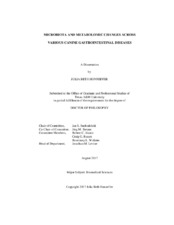| dc.description.abstract | The canine gastrointestinal tract (GIT) is home to a complex ecosystem known as the microbiome. The microbiota (i.e., bacteria, viruses, fungi, and protozoa) are metabolically active, augmenting host digestion and thereby influencing the host, depending on both community composition and metabolic function. The upper GIT is physiologically different from the lower GIT, but feces are still frequently used as a representative sample due to the ease and noninvasiveness of collection. Previous studies in dogs as well as in humans have shown metabolic and microbiota changes in feces associated with various disease states. Our study aims were to characterize the microbiome at different sites of the canine gastrointestinal tract using sequencing and metabolomics; identify potential biomarkers in feces of dogs with chronic enteropathy (CE) by comparing their fecal composition with that in healthy dogs using sequencing and metabolomics; develop and analytically validate a quantitative assay for potential biomarkers; and use this assay to investigate altered concentrations associated with various gastrointestinal diseases in dogs at a single time point and over time.
Characterization of the contents of the duodenum, ileum, colon, and rectum revealed shifting compositions of both the microbiota and the metabolome. Major microbiota differences included distally increasing Firmicutes and decreasing Proteobacteria, while the differences in the metabolome largely reflected absorptive processes (e.g., decreasing concentrations of amino acids as these are absorbed by the host). In feces of dogs with CE, relative amounts of phytosterols were decreased and abundances of some fatty acids were altered. Thus a quantitative assay for fecal sterols and fatty acids (“FASter”) was developed, analytically validated, and used to analyze samples from dogs diagnosed with CE, acute hemorrhagic diarrhea syndrome (AHDS), or exocrine pancreatic insufficiency (EPI). FASter profiles differed among the different groups of dogs. The FASter profile of dogs with AHDS rapidly shifted towards that of healthy dogs, while in CE the profile exhibited little change over time.
Additional studies are warranted to continue to elucidate the role of lipid metabolism in canine gastrointestinal diseases, and determine whether fecal metabolite profiles can be of diagnostic use or even lead to a novel therapeutic approach. | en |


